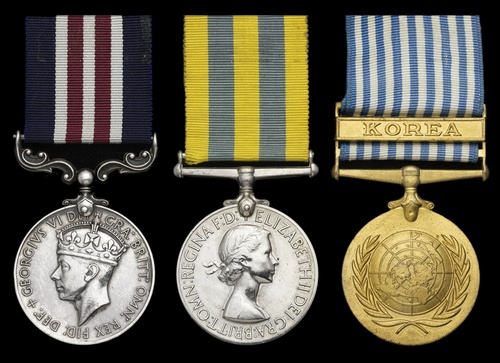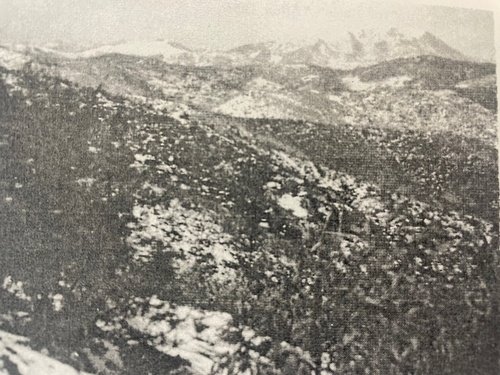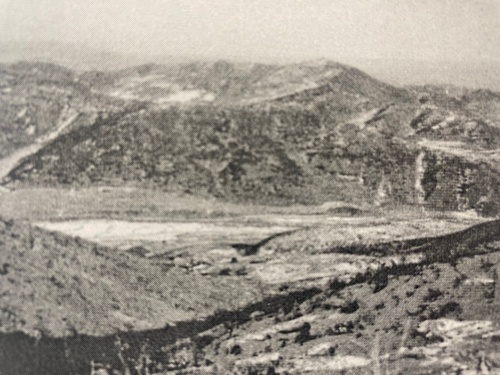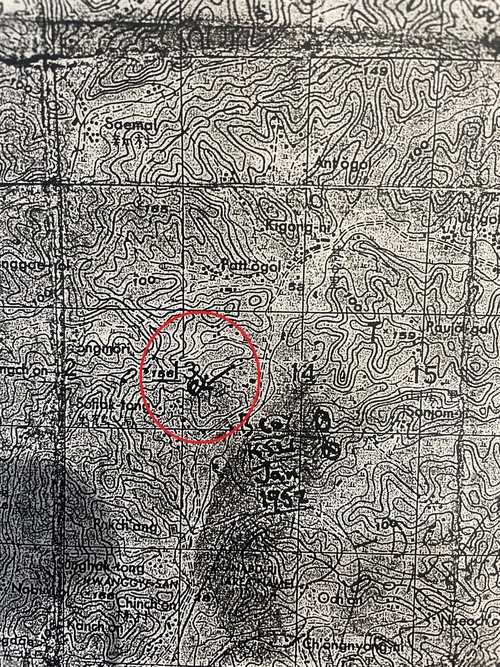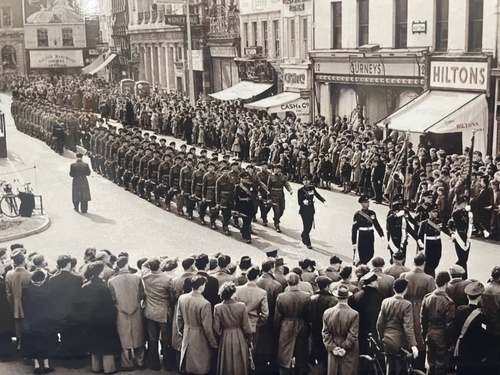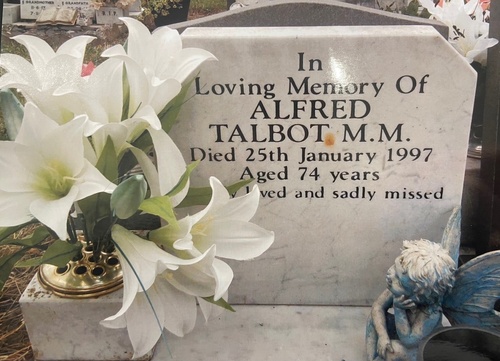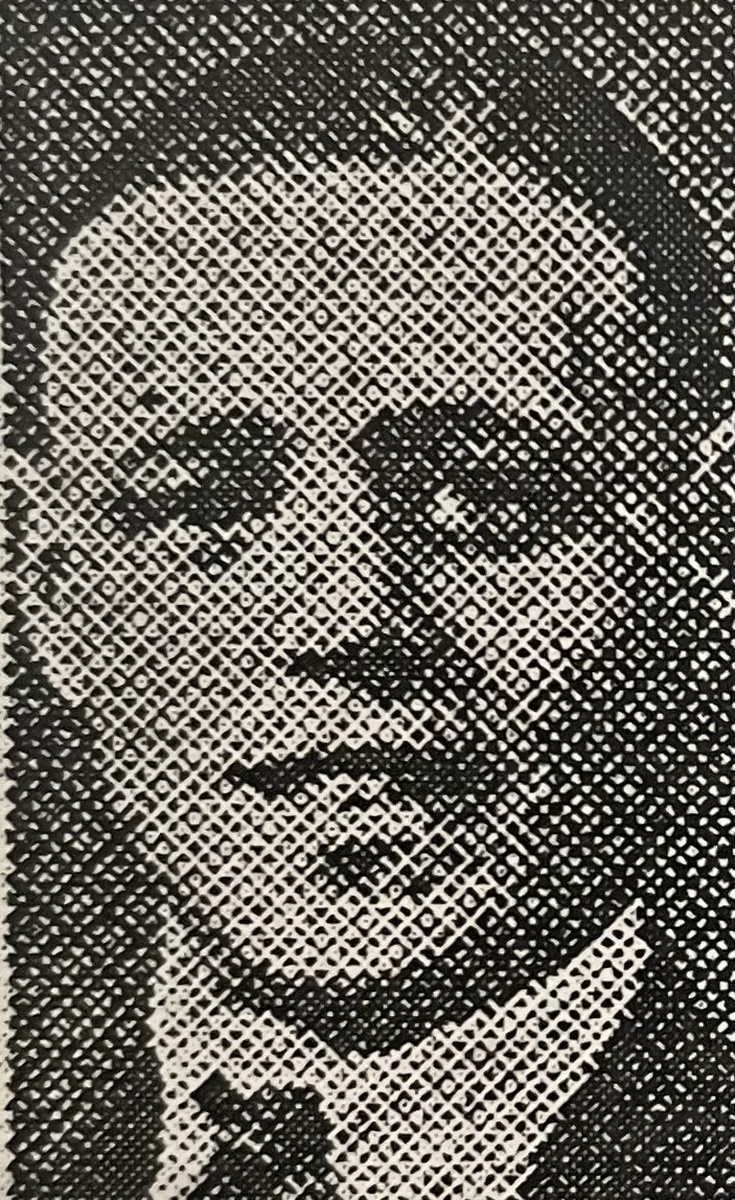Auction: 25001 - Orders, Decorations and Medals
Lot: 367
A very fine Korean War M.M. group of three awarded to Corporal A. Talbot, 1st Battalion, King's Shropshire Light Infantry
A Regular soldier who shared in 'every action' in which his unit shared - including Operation 'Commando' in October 1951 - he won his M.M. for his gallantry during a fighting patrol when his Officer was severely wounded in the act of destroying an enemy bunker; Talbot sprung to action and assumed command of the Cover Party, saving the life of the stricken Subaltern by dressing his wounds and bringing down effective artillery fire to allow their coming out under a heavy hail of fire - he would go up to Buckingham Palace in March 1953 to receive his M.M. from the hands of The Queen
Military Medal, G.VI.R., 2nd issue (19043240 A. Cpl. A. Talbot. K.S.L.I.), minor official correction to surname; Korea 1950-53 (19043240 Cpl. A. Talbot. K.S.L.I.); U.N. Korea 1950-54, good very fine (3)
M.M. London Gazette 10 October 1952. The original recommendation - from Lieutenant-Colonel Barlow D.S.O., O.B.E., CO 1KSLI and dated 6 June 1952 - states:
'Cpl Talbot has been a Rifle Section Commander in "B" Company 1 KSLI for the past thirteen months.
Throughout this period he has demonstrated the highest qualities of a junior NCO. Loyal, sturdy in action, and determined to carry out his orders, he has participated in every action in which the Battalion has been involved.
In particular on the night of the 29th January, Cpl Talbot was second in command of a fighting patrol, which was ordered to destroy an enemy occupied bunker.
The bunker was located approximately 1,200 yards from the Company position. The patrol commander, 2/Lt Whybrow, dropped off a covering party 200 yards from his objective. Cpl Talbot was left in command of the covering party, consisting of himself, a wireless operator, and a bren group. On entering the bunker, 2/Lt Whybrow was seriously wounded and he ordered his patrol to leave him and return to the Company positions. Cpl Talbot then took command of the patrol and acted with great coolness. He passed an accurate account of the situation to Company HQ, which enabled artillery fire to be brought down to cover the withdrawal of the patrol. He then proceeded forward to the objective and moved 2/Lt Whybrow into dead ground, where he dressed his wounds and stopped him bleeding. He then ordered the party, carrying 2/Lt Whybrow back across no mans land, to the foot of the Company position. He moved his party back by bounds and kept Company HQ informed of his movements thus enabling artillery fire to be placed. This undoubtedly stopped the enemy from following up the patrol. 2/Lt Whybrow's life was saved and further casualties were inflicted on this patrol.
This young NCO has over a long period commanded his section with skill and bravery and his devotion to duty merits recognition.'
Alfred Talbot was born in November 1922 and was a native of East Garforth, near Leeds, West Yorkshire. Having been exempted from service during the Second World War as he was a farm labourer at Manor Farm, Garforth, he joined the King's Own Yorkshire Light Infantry as a Regular in 1947. He was transferred to the King's Shropshire Light Infantry at Hong Kong for the Korean War. The Battalion was then sent to Korea on 13 May to take over from the Middlesex Regiment.
Operation Commando
The object was for the K.O.S.B. to capture Point 355, with the K.S.L.I. supporting the left flank, with Centurion tanks from A Squadron, 8 Hussars being available as and when required. Early on 3 October 1951, D Company attacked and occupied Point 208. B Company - with Talbot to the fore - then passed through to occupy the next hill, incurring six wounded. C Company pushed through and attacked a spur; supported by fire from B Company they captured the position with two killed and seven more wounded.
These positions were consolidated and held overnight. As dawn broke on 4 October, D Company went forward with tanks following on behind. The Company was to attack Point 210. As they moved forward they came under sustained fire from a heavy Chinese Machine Gun (M.G.). A Bren was sent to a suitable feature and engage the M.G., with the words "go and find it and get rid of it." With four magazines in his pouches, Lance-Corporal Norton (who won an M.M.) set off on the right flank looking for the enemy position. As he was getting into cover he was wounded by a ricochet in his left thigh. Ignoring his wound he engaged the M.G. and successfully knocked it out; it was later found to have been manned by three Chinese. This gun is now on display at the K.S.L.I. Museum. Whybrow noted the part he and Talbot would have played:
''D' Company passed through with tank support and Andrew and I tackled the twin features comprising Pt 210. A bayonet charge in true story book style resulted in 10 Chinese dead and 12 Prisoners. Three of my chaps were hit. Platoon displayed guts and determination.'
The following months saw the unit throw off numerous 'human wave' attacks from the enemy in order to hold their ground. It was to be that 'Hill 227' was added to the Battle Honours, much like 'Hill 355 ' for the K.O.S.B.
Fighting patrol - M.M.
The events which saw Talbot take his M.M., along with Whybrow losing his leg below the knee - and an M.C. for his troubles - are well described in the official citation. However, Dawney Bancroft wrote to the family of Whybrow after the events:
'Pte Tearney was the man who endeavoured to cover John into the bunker. The entrance being so narrow this proved impossible. When John was hit, he pulled him out and threw him clear of further bullets. Tearney then sent [one of the brew-up group] to Cpl. Talbot, who was covering them with a machine gun [Bren at Bd. 3].
Pte Bennett, the wireless operator, then got straight on to me and gave me exact details of the situation. His coolness and prompt action enabled me to take charge and cover the patrol back by boxing off the area with fire from various weapons.
This probably prevented the enemy from following up. Cpl Talbot took charge of the withdrawal, which he did magnificently. Once they got him [John] into dead ground, he placed first field dressings on his wounds, which stopped the flow of blood and then wasted no time in getting him back to me. I couldn't have wished for
a better conducted withdrawal. They worked as a first class patrol should do.
Most praise must go to Cpl Talbot, and to Ptes Bennet and Teamey. (...) You will be glad to hear that John's old platoon hit back [later] with good measure to the score of 7-0. It has done their morale an enormous lot of good as they were a sad-faced lot for some days after John left.'
Talbot would sail home in September 1952 and was to be re-united with Whybrow in March 1953 in order to be presented his richly-deserved G.VI.R. M.M. from the hands of The Queen at Buckingham Palace. It is fitting it bears his effigy, having been earned on 29 January 1952, just a few days before the passing of King George VI at Sandringham on 6 February 1952.
Talbot was married for the first time at Garforth in August 1953. He died, having re-married, in Lincolnshire in January 1997; sold together with copied research, newspaper cuttings including portrait photograph and John Whybrow's Korea 1951-52 - Some personal impressions.
Subject to 20% VAT on Buyer’s Premium. For more information please view Terms and Conditions for Buyers.
Estimate
£3,000 to £4,000
Starting price
£2500

